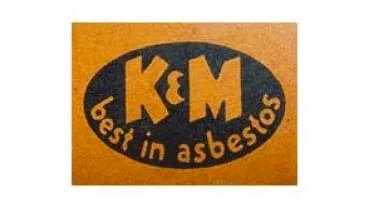Nicolet/Keasbey & Mattison
Nicolet (Keasbey & Mattison) made many different types of asbestos-containing construction materials that caused workers to develop related diseases. Asbestos litigation forced the company into bankruptcy and required the establishment of a trust fund to handle future claims.

Keasbey & Mattison’s History with Asbestos
The Nicolet Company, formerly known as Keasbey & Mattison, has an unusual background story for a business that made asbestos products. Known in construction circles for pipe insulation, the company began as a pharmaceutical firm.
In its early days, Keasbey & Mattison produced patent medications. The company soon changed its focus when it discovered a lucrative new product. Mattison found that mixing the laxative Milk of Magnesia with asbestos created a useful material for pipe insulation.
By 1886, the company was focused on the production of construction and industrial materials that contained asbestos. Keasbey & Mattison shortened its name to “K&M” at the beginning of the 20th century, and fast became one of the country’s leading manufacturers of asbestos textiles and products.
The company had changed ownership a few times by the early 1960s when it was acquired by Nicolet Industries. Nicolet continued to make automobile parts and asbestos products until it filed for bankruptcy in 1987 after being named a defendant in more than 61,000 personal injury cases involving asbestos.
It eventually became a division of Armstrong World Industries. All asbestos claims are now being paid by the Armstrong World Industries Asbestos Personal Injury Settlement Trust.

Gain access to trust funds, grants and other forms of compensation for you or your loved ones.
Get Help NowAsbestos Litigation Involving Keasbey & Mattison
In 1987, Keith Edwin Gibson successfully sued Armstrong World Industries for damages sustained through exposure to Keasbey & Mattison’s insulation products.
The U.S. District Court of Colorado decided that because Nicolet had purchased K&M’s assets and continued to manufacture its asbestos products, Nicolet was Keasbey & Mattison’s “successor-in-interest.” Because Armstrong World Industries absorbed Nicolet, the company became responsible for all suits filed against Nicolet and K&M.
This landmark court decision established a precedent that allowed mesothelioma victims to pursue compensation from multiple asbestos companies. It also established that companies are responsible under Colorado law for both the assets and liabilities of the businesses they purchase.
Bankruptcy and Trust Fund
The Armstrong World Industries Asbestos Personal Injury Settlement Trust began accepting claims in 2007 to compensate victims of Nicolet and K&M asbestos products. The trust received initial funding of $2.11 billion. By 2017, $312 million in claim payments had been made from the trust.
In 2019, the trust lowered its payment schedule to 26%, which is the percentage of a claim the trust will pay to make sure sufficient funds remain in the trust for future claims. In comparison to other asbestos trust funds, this payment percentage is higher than average.
Keasbey & Mattison’s Asbestos Products
Asbestos products made by K&M included:
- Air-Cell Pipe Covering
- Ambler Asbestos Fibers
- Amberlerex No. 2 Asbestos Cement
- Asbestos-containing Lumber
- Asbestos Electrical Tape
- Asbestos Electrical Tubing
- Asbestos Furnace Cement
- Asbestos Millboard
- Asbestos Paper
- Asbestos Pipe Joint Tape
- Asbestos Roll Board
- Asbestos Textiles
- Asbestos Wick Packing
- Automotive Gaskets
- Bestfelt Pipe Insulation
- Century Asbestos Corrugated Roofing
- Century Asbestos Corrugated Siding
- Century Asbestos Shingles
- Century Asbestos-Cement Shingles
- Compressed Asbestos Sheet Packings
- Duplex Wrap Insulation
- Ebonized Asbestos Sheets
- Featherweight Insulating Cement
- Fireproof Curtains
- Hy-Temp Pipe Insulation
- Insupanel
- Kay-Therm Pipe Covering
- Kolor-Mate Asbestos Cement Composition Board
- Linabestos Siding
- Monobestos Cement
- Rope Packing
- Sheetflextos Cement
- Simplex Pipe Covering
- Sprayed Limpet Asbestos
- TexMo Brake Lining
- Twisted Asbestos Rope Packing
- Trafford Tile
- Waltile
- White Cold Molded Asbestos
- Zebra Insulation
Occupations at Risk of Exposure to Keasbey & Mattison’s Asbestos Products
The following occupations faced risk of exposure to asbestos through Keasbey & Mattison’s products:
- Automobile factory workers
- Automotive mechanics
- Boiler workers
- Brake mechanics
- Carpenters
- Construction workers
- Electricians
- Interior decorators
- K&M employees
- Insulators
- Maintenance workers
- Pipefitters
- Plumbers
- Roofers
K&M products were used in just about every aspect of the construction industry, from roofing to pipe fittings. Asbestos-containing K&M products may still be found in homes built prior to 1990, presenting a potential hazard to workers involved in the maintenance, repair, remodeling or demolition of older structures.
The company also manufactured automotive parts until 1987 which put automobile factory workers and auto mechanics at risk of exposure. According to a 2022 report by the European Commission, over 70,000 workers died in 2019 from past exposure to asbestos.
K&M produced a variety of asbestos textile products, including aprons, clothing, gloves, hats, helmets, thread, yarn and union suits. Workers who helped manufacture these materials faced direct contact with asbestos fibers.
Keasbey & Mattison’s Company History
In 1881, Henry G. Keasbey and business partner Dr. Richard V. Mattison moved their pharmaceutical company, Keasbey & Mattison, from Philadelphia to the small town of Ambler, Pennsylvania.
Ambler’s residents hoped the company would help rebuild the town’s economy. For a while, prosperity returned to Ambler as jobs at the Keasbey & Mattison factories and warehouses lured new residents to the area. The civic-minded Mattison even built an opera house and a new library.
In 1934, Keasbey & Mattison was sold to the British company Turner & Newall, which continued to operate the core business until 1962. That is when Turner & Newall was sold to two other firms, CertainTeed Corporation and Nicolet Industries.
Turner & Newall entered into an exclusive licensing agreement with Armstrong World Industries from 1962 to 1967 to distribute Sprayed Limpet Asbestos in the U.S.
Nicolet was eventually acquired by Armstrong World Industries, which filed for bankruptcy in 2000.
EPA Superfund Site
Decades of asbestos waste dumping by K&M, Turner & Newall and Nicolet resulted in several acres of land being designated a Superfund site in Ambler, Pennsylvania. The area, called the BoRit Superfund Asbestos Site, was added to the U.S. Environmental Protection Agency’s National Priorities List in 2009. The site contains asbestos waste made up of shingles, millboard, piping and tiles.
One of the waste piles was actually used as a playground and public park for a number of years. It was closed in the mid-1980s because of asbestos contamination. Some of the piles of waste were as much as 30 feet tall, and at least 15 feet deep below ground level.
The EPA had initially begun cleanup proceedings in Ambler In 1985. The agency initiated a lawsuit against Nicolet (United States of America v. Nicolet, Inc. and Turner Newall, PLC) to recover costs and expenses already used in the cleanup in Ambler.
It issued the final cleanup plan for the BoRit site on July 28, 2017. In November 2017, the agency released its Final Operations and Maintenance Plan for the site. The cleanup includes covering the asbestos-containing wastes, soils and reservoir sediments with geotextile and a minimum of two feet of clean material. Air testing demonstrated there is no unacceptable risk from airborne asbestos in the surrounding community.
Recommended Reading


